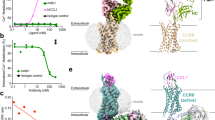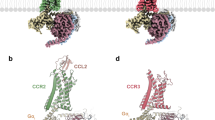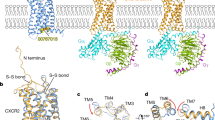Abstract
CC chemokine receptor 2 (CCR2) is one of 19 members of the chemokine receptor subfamily of human class A G-protein-coupled receptors. CCR2 is expressed on monocytes, immature dendritic cells, and T-cell subpopulations, and mediates their migration towards endogenous CC chemokine ligands such as CCL2 (ref. 1). CCR2 and its ligands are implicated in numerous inflammatory and neurodegenerative diseases2 including atherosclerosis, multiple sclerosis, asthma, neuropathic pain, and diabetic nephropathy, as well as cancer3. These disease associations have motivated numerous preclinical studies and clinical trials4 (see http://www.clinicaltrials.gov) in search of therapies that target the CCR2–chemokine axis. To aid drug discovery efforts5, here we solve a structure of CCR2 in a ternary complex with an orthosteric (BMS-681 (ref. 6)) and allosteric (CCR2-RA-[R]7) antagonist. BMS-681 inhibits chemokine binding by occupying the orthosteric pocket of the receptor in a previously unseen binding mode. CCR2-RA-[R] binds in a novel, highly druggable pocket that is the most intracellular allosteric site observed in class A G-protein-coupled receptors so far; this site spatially overlaps the G-protein-binding site in homologous receptors. CCR2-RA-[R] inhibits CCR2 non-competitively by blocking activation-associated conformational changes and formation of the G-protein-binding interface. The conformational signature of the conserved microswitch residues observed in double-antagonist-bound CCR2 resembles the most inactive G-protein-coupled receptor structures solved so far. Like other protein–protein interactions, receptor–chemokine complexes are considered challenging therapeutic targets for small molecules, and the present structure suggests diverse pocket epitopes that can be exploited to overcome obstacles in drug design.
This is a preview of subscription content, access via your institution
Access options
Subscribe to this journal
Receive 51 print issues and online access
$199.00 per year
only $3.90 per issue
Buy this article
- Purchase on Springer Link
- Instant access to full article PDF
Prices may be subject to local taxes which are calculated during checkout




Similar content being viewed by others
References
Scholten, D. J. et al. Pharmacological modulation of chemokine receptor function. Br. J. Pharmacol. 165, 1617–1643 (2012)
O’Connor, T., Borsig, L. & Heikenwalder, M. CCL2-CCR2 signaling in disease pathogenesis. Endocr. Metab. Immune Disord. Drug Targets 15, 105–118 (2015)
Lim, S. Y., Yuzhalin, A. E., Gordon-Weeks, A. N. & Muschel, R. J. Targeting the CCL2-CCR2 signaling axis in cancer metastasis. Oncotarget 7, 28697–28710 (2016)
Solari, R., Pease, J. E. & Begg, M. “Chemokine receptors as therapeutic targets: why aren’t there more drugs?”. Eur. J. Pharmacol. 746, 363–367 (2015)
Cooke, R. M., Brown, A. J., Marshall, F. H. & Mason, J. S. Structures of G protein-coupled receptors reveal new opportunities for drug discovery. Drug Discov. Today 20, 1355–1364 (2015)
Carter, P. H. et al. Discovery of a potent and orally bioavailable dual antagonist of CC chemokine receptors 2 and 5. ACS Med. Chem. Lett. 6, 439–444 (2015)
Dasse, O. et al. Novel, acidic CCR2 receptor antagonists: lead optimization. Lett. Drug Des. Discov. 4, 263–271 (2007)
Caffrey, M. & Cherezov, V. Crystallizing membrane proteins using lipidic mesophases. Nature Protocols 4, 706–731 (2009)
Wu, B. et al. Structures of the CXCR4 chemokine GPCR with small-molecule and cyclic peptide antagonists. Science 330, 1066–1071 (2010)
Tan, Q. et al. Structure of the CCR5 chemokine receptor-HIV entry inhibitor maraviroc complex. Science 341, 1387–1390 (2013)
Qin, L. et al. Structural biology. Crystal structure of the chemokine receptor CXCR4 in complex with a viral chemokine. Science 347, 1117–1122 (2015)
Burg, J. S. et al. Structural basis for chemokine recognition and activation of a viral G protein-coupled receptor. Science 347, 1113–1117 (2015)
Monteclaro, F. S. & Charo, I. F. The amino-terminal domain of CCR2 is both necessary and sufficient for high affinity binding of monocyte chemoattractant protein 1. Receptor activation by a pseudo-tethered ligand. J. Biol. Chem. 272, 23186–23190 (1997)
Zhang, K. et al. Structure of the human P2Y12 receptor in complex with an antithrombotic drug. Nature 509, 115–118 (2014)
Weik, M. et al. Specific chemical and structural damage to proteins produced by synchrotron radiation. Proc. Natl Acad. Sci. USA 97, 623–628 (2000)
Cherney, R. J. et al. Discovery of disubstituted cyclohexanes as a new class of CC chemokine receptor 2 antagonists. J. Med. Chem. 51, 721–724 (2008)
Berkhout, T. A. et al. CCR2: characterization of the antagonist binding site from a combined receptor modeling/mutagenesis approach. J. Med. Chem. 46, 4070–4086 (2003)
Hall, S. E. et al. Elucidation of binding sites of dual antagonists in the human chemokine receptors CCR2 and CCR5. Mol. Pharmacol. 75, 1325–1336 (2009)
Cherney, R. J. et al. Synthesis and evaluation of cis-3,4-disubstituted piperidines as potent CC chemokine receptor 2 (CCR2) antagonists. Bioorg. Med. Chem. Lett. 18, 5063–5065 (2008)
Zweemer, A. J. et al. Discovery and mapping of an intracellular antagonist binding site at the chemokine receptor CCR2. Mol. Pharmacol. 86, 358–368 (2014)
Blankenship, E., Vahedi-Faridi, A. & Lodowski, D. T. The high-resolution structure of activated opsin reveals a conserved solvent network in the transmembrane region essential for activation. Structure 23, 2358–2364 (2015)
Rasmussen, S. G. et al. Crystal structure of the β2 adrenergic receptor–Gs protein complex. Nature 477, 549–555 (2011)
Zweemer, A. J. et al. Multiple binding sites for small-molecule antagonists at the CC chemokine receptor 2. Mol. Pharmacol. 84, 551–561 (2013)
Hino, T. et al. G-protein-coupled receptor inactivation by an allosteric inverse-agonist antibody. Nature 482, 237–240 (2012)
Staus, D. P. et al. Allosteric nanobodies reveal the dynamic range and diverse mechanisms of G-protein-coupled receptor activation. Nature 535, 448–452 (2016)
Katritch, V., Cherezov, V. & Stevens, R. C. Structure-function of the G protein-coupled receptor superfamily. Annu. Rev. Pharmacol. Toxicol. 53, 531–556 (2013)
Manglik, A. et al. Structural insights into the dynamic process of β2-adrenergic receptor signaling. Cell 161, 1101–1111 (2015)
Palczewski, K. et al. Crystal structure of rhodopsin: a G protein-coupled receptor. Science 289, 739–745 (2000)
Rasmussen, S. G. et al. Crystal structure of the human β2 adrenergic G-protein-coupled receptor. Nature 450, 383–387 (2007)
Pease, J. & Horuk, R. Chemokine receptor antagonists. J. Med. Chem. 55, 9363–9392 (2012)
Andrews, G., Jones, C. & Wreggett, K. A. An intracellular allosteric site for a specific class of antagonists of the CC chemokine G protein-coupled receptors CCR4 and CCR5. Mol. Pharmacol. 73, 855–867 (2008)
Nicholls, D. J. et al. Identification of a putative intracellular allosteric antagonist binding-site in the CXC chemokine receptors 1 and 2. Mol. Pharmacol. 74, 1193–1202 (2008)
Alexandrov, A. I., Mileni, M., Chien, E. Y. T., Hanson, M. A. & Stevens, R. C. Microscale fluorescent thermal stability assay for membrane proteins. Structure 16, 351–359 (2008)
Cherezov, V. et al. Rastering strategy for screening and centring of microcrystal samples of human membrane proteins with a sub-10 μm size X-ray synchrotron beam. J. R. Soc. Interface 6 (Suppl. 5), S587–S597 (2009)
Kabsch, W. Xds. Acta Crystallogr. D 66, 125–132 (2010)
Winn, M. D. et al. Overview of the CCP4 suite and current developments. Acta Crystallogr. D 67, 235–242 (2011)
McCoy, A. J. et al. Phaser crystallographic software. J. Appl. Crystallogr. 40, 658–674 (2007)
Adams, P. D. et al. PHENIX: a comprehensive Python-based system for macromolecular structure solution. Acta Crystallogr. D 66, 213–221 (2010)
Emsley, P., Lohkamp, B., Scott, W. G. & Cowtan, K. Features and development of Coot. Acta Crystallogr. D 66, 486–501 (2010)
Doyon, J. et al. Discovery of potent, orally bioavailable small-molecule inhibitors of the human CCR2 receptor. ChemMedChem 3, 660–669 (2008)
Brodmerkel, C. M. et al. Discovery and pharmacological characterization of a novel rodent-active CCR2 antagonist, INCB3344. J. Immunol. 175, 5370–5378 (2005)
Chen, V. B. et al. MolProbity: all-atom structure validation for macromolecular crystallography. Acta Crystallogr. D 66, 12–21 (2010)
Acknowledgements
We thank A. Ishchenko and H. Zhang for help with X-ray data collection, C. Wang and H. X. Wu for suggestions on construct design, F. Li for help with data processing, and M. Galella for assistance with BMS compound data and statistics. We thank C. Ogata, R. Sanishvili, N. Venugopalan, M. Becker, and S. Corcoran at beamline 23ID at GM/CA CAT Advanced Photon Source. Funding for this research was provided by National Institutes of Health grants R01 GM071872, U54 GM094618, R01 AI118985, R21 AI121918, and R21 AI122211. GM/CA@APS has been funded in whole or in part with federal funds from the National Cancer Institute (ACB-12002) and the National Institute of General Medical Sciences (AGM-12006). This research used resources of the Advanced Photon Source, a US Department of Energy (DOE) Office of Science User Facility operated for the DOE Office of Science by Argonne National Laboratory under contract number DE-AC02-06CH11357.
Author information
Authors and Affiliations
Contributions
I.K. and T.M.H. designed the study and coordinated all experiments. Y.Z. designed and engineered protein constructs, performed crystallization experiments, collected the diffraction data, and determined the structure. L.Q., M.G., and C.Z. assisted with protein engineering and crystallization. G.W.H. assisted with structure determination and refinement. A.P.I. and L.H.H. designed, and N.V.O.Z. and H.d.V. performed, equilibrium and kinetics binding experiments. I.K. performed computational and bioinformatics analyses. R.J.C., P.C., and A.T. synthesized, characterized, and crystallized the BMS compound analogues. M.D. assisted with compound crystallization. D.S. assisted with the allosteric compound characterization. R.A. assisted with structure analysis. V.C. and R.C.S. assisted with crystallization. Y.Z., N.V.O.Z., A.P.I., L.H.H., I.K., and T.M.H. wrote the paper.
Corresponding authors
Ethics declarations
Competing interests
R.A. has an equity interest in Molsoft, LLC. The terms of this arrangement have been reviewed and approved by the University of California, San Diego in accordance with its conflict of interest policies. R.C., P.C., and A.T. are employees of Bristol-Myers Squibb Company. D.S. is an employee of Vertex Pharmaceuticals, Inc.
Extended data figures and tables
Extended Data Figure 1 CCR2-T4L crystals and crystal packing.
a–c, Crystal packing of CCR2-T4L. CCR2 is a blue ribbon with ECL2 coloured red and T4L yellow. The unit cell is shown as a green box. CCR2-T4L molecules are arranged in a type I packing with hydrophilic stacking mediated by T4L and T4L–ECL2 interactions along axis c. a, Crystal packing in the ac plane. CCR2 makes abundant hydrophobic contacts with its neighbour via an interface mediated by antiparallel helix IV–helix VI interactions related by a screw axis along axis a. b, Crystal packing in the bc plane. Contacts between receptors and T4L involve ECL2 and the intracellular surface of CCR2 including helix VIII. Direct contacts between T4L are along axis b. One layer of CCR2-T4L molecules at the very top of the stacking column is omitted for clarity. c, Crystal packing in the ab plane. There are no direct interactions between T4L along axis a. d, Crystals of CCR2-T4L in the LCP bolus. Average crystals grew to 60 μm × 10 μm × 10 μm before harvesting.
Extended Data Figure 2 BMS-681 binding may disrupt a chemokine-recognizing conformation of the CCR2 N terminus and helix I.
a, Model of CCR2–CCL2 built by homology from the structure of CXCR4–vMIP-II11 suggests that a productive chemokine-compatible conformation of the receptor requires re-orientation of the N terminus from almost parallel to almost perpendicular to the membrane plane, and formation of an extra helical turn in helix I to bring it closer to helix VII and ECL3. b, Binding of BMS-681 may disrupt this chemokine-compatible conformation by inserting between helices I and VII.
Extended Data Figure 3 CCR2-RA-[R] directly binds to CCR2 residues that are homologous to those involved in G-protein coupling in other GPCRs.
Partial alignment of intracellular regions of CCR2 and homologous regions in bovine Rho (bRho) and β2 adrenergic receptor (β2AR), alongside profile of contacts that CCR2-RA-[R], the Gαt C-terminal peptide21, and Gαs C terminus22 make with the three respective receptors. Contacts are shown by circles above and below the alignment, with circle area indicative of contact strength. Backbone and side-chain contacts are grey and black, respectively. Assuming structural homology between the CCR2–G-protein interface and at least one of the bRho–Gαt and β2AR–Gαs interfaces, several residue positions seem to be involved in binding both CCR2-RA-[R] and the C terminus of the G protein.
Extended Data Figure 4 Equilibrium binding and binding kinetics of BMS-681 and CCR2-RA-[R] with WT CCR2 and CCR2-T4L.
a, b, Displacement of [3H]INCB-3344 (5 nM, a) and [3H]CCR2-RA-[R] (3 nM, b) from WT CCR2 and CCR2-T4L in CHO cells by increasing concentrations of unlabelled INCB-3344, CCR2-RA-[R] and BMS-681. c, d, Association and (e, f) dissociation of 7 nM [3H]CCR2-RA from CHO cell membranes transiently expressing WT CCR2 (c, e) or CCR2-T4L (d, f) at 25 °C, in the absence or presence of 1 μM BMS-681. Figures represent normalized and combined data from three independent experiments performed in duplicate, with results presented as mean ± s.e.m. percentage of specific [3H]CCR2-RA binding.
Extended Data Figure 5 A Zn2+ binding site was identified by X-ray fluorescence emission analysis of the CCR2-T4L–BMS-681–CCR2-RA-[R] crystals.
a, View of the Zn2+ ion at an interface formed by CCR2 helices III and VI and the N terminus of T4L. The Zn2+ ion is coordinated by side chains of H1443.56 (from WT receptor), E2386.30 (from the engineered part of the receptor), and E1005 (from T4L) as well as a structured water. b, Background fluorescence signal of an empty MiTeGen micromount is low, indicating the absence of metal ion. Excitation at 12 keV results in a peak at 11.7 keV (owing to the incidence beam). c, X-ray fluorescence emission signal from a wide fluorescence scan of the CCR2-T4L crystal. The fluorescence peaks at 8.60 keV and 9.53 keV correspond to X-ray emission lines Kα (8.64 keV) and Kβ (9.57 keV) and indicate the presence of Zn2+ bound to CCR2-T4L. d, A zoomed-in view of the X-ray fluorescence emission signal from c.
Rights and permissions
About this article
Cite this article
Zheng, Y., Qin, L., Zacarías, N. et al. Structure of CC chemokine receptor 2 with orthosteric and allosteric antagonists. Nature 540, 458–461 (2016). https://doi.org/10.1038/nature20605
Received:
Accepted:
Published:
Issue Date:
DOI: https://doi.org/10.1038/nature20605
This article is cited by
-
Structure basis for the modulation of CXC chemokine receptor 3 by antagonist AMG487
Cell Discovery (2023)
-
Class B1 GPCR activation by an intracellular agonist
Nature (2023)
-
Autoantibodies against chemokines post-SARS-CoV-2 infection correlate with disease course
Nature Immunology (2023)
-
Universal platform for the generation of thermostabilized GPCRs that crystallize in LCP
Nature Protocols (2022)
-
Allosteric modulation of dopamine D2L receptor in complex with Gi1 and Gi2 proteins: the effect of subtle structural and stereochemical ligand modifications
Pharmacological Reports (2022)
Comments
By submitting a comment you agree to abide by our Terms and Community Guidelines. If you find something abusive or that does not comply with our terms or guidelines please flag it as inappropriate.



